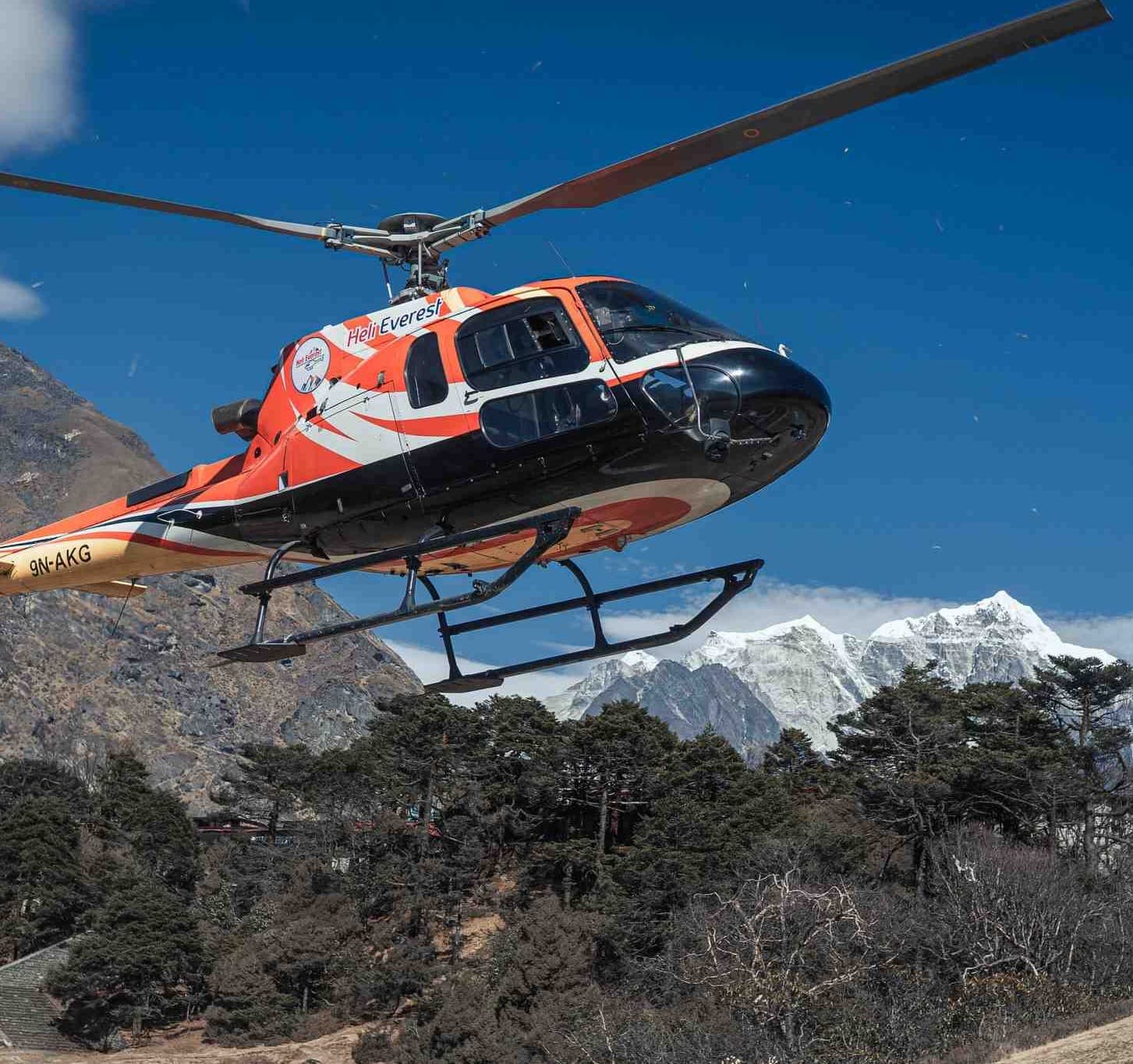The Annapurna Base Camp Trek with Helicopter Return - 9 Days is an extraordinary blend of adventure, natural beauty, and luxury. This journey takes you through diverse landscapes, from terraced fields and lush forests to high-altitude alpine terrain, offering breathtaking views of the Annapurna and Dhaulagiri ranges. As you trek through charming Gurung and Magar villages, you'll experience the warm hospitality of the local people, making this trek as culturally enriching as it is scenic. Reaching the Annapurna Base Camp at 4,210 meters is a rewarding highlight, where you'll find yourself surrounded by towering peaks and unparalleled serenity.
(For Group rates and discounts please contact us at - Direct Call: +977-9851005129 (Nepal) and +1 916 794 8443 (USA) / Whatsapp: +977-9851005129 )
What sets this trek apart is the luxurious helicopter ride back from Annapurna Base Camp to Pokhara, providing a thrilling aerial perspective of the stunning Himalayas. This thoughtfully designed itinerary by Luxury Holidays Nepal ensures a seamless experience with premium accommodations, expert guides, and all necessary arrangements. Whether you're a seasoned trekker or a first-timer looking for an exclusive adventure, this 9-day trek offers the perfect combination of challenge, comfort, and unforgettable memories.
Major Highlights of Annapurna Base Camp Trek with Helicopter Return
- Panoramic Mountain Views: Witness breathtaking vistas of Annapurna, Dhaulagiri, Machhapuchhre (Fishtail), and other Himalayan peaks.
- Scenic Helicopter Ride: Enjoy a luxurious and time-efficient helicopter return from Annapurna Base Camp to Pokhara, offering stunning aerial views of the Himalayas.
- Cultural Immersion: Explore traditional Gurung and Magar villages, experiencing their warm hospitality, unique culture, and vibrant traditions.
- Poon Hill Sunrise: A hike to Poon Hill (3,210m) for a mesmerizing sunrise view over the Annapurna and Dhaulagiri ranges.
- Diverse Landscapes: Trek through subtropical forests, terraced fields, riversides, and alpine meadows, experiencing Nepal's diverse natural beauty.
- Annapurna Base Camp (4,210m): Reach the iconic Annapurna Base Camp, a natural amphitheater surrounded by towering snow-clad peaks.
- Comfortable Lodging and Meals: Stay at the best available guesthouses during the trek and savor delicious local and international cuisine.
- Expert Guidance and Support: Trek with licensed guides, skilled porters, and seamless logistics managed by Luxury Holidays Nepal.
- Accessible and Hassle-Free: A carefully curated itinerary with domestic flights, luxury transfers, and all necessary permits included.
- Perfect Blend of Adventure and Luxury: Combine the thrill of trekking with the ease and luxury of a scenic helicopter return, making it a unique and unforgettable experience.
Route Overview
The Annapurna Base Camp Trek with Helicopter Return takes you through one of Nepal’s most diverse and scenic trekking routes. Starting from Tikhe Dhunga after a short flight to Pokhara, the trail winds through lush rhododendron forests, terraced farmlands, and quaint villages inhabited by Gurung and Magar communities. As you ascend, the landscape transitions from subtropical forests to alpine meadows, offering ever-changing vistas of the Himalayas. The trek includes a stop at the famous Poon Hill, where a sunrise hike rewards you with panoramic views of Annapurna, Dhaulagiri, and Machhapuchhre (Fishtail) peaks.
Continuing onward, the trail leads to Annapurna Base Camp (4,210m), a natural amphitheater surrounded by towering snow-capped mountains. The journey culminates in a luxurious private helicopter ride back to Pokhara, providing a bird's-eye view of the stunning landscapes trekked over the previous days. This thoughtfully designed route, crafted by Luxury Holidays Nepal, ensures a perfect balance of adventure, cultural immersion, and luxurious comfort, making it an unforgettable experience for all.
Alternative Tours
We offer a range of similar Helicopter Trekking Adventures in Nepal, combining thrilling treks with luxurious helicopter rides to create unforgettable journeys. Explore the following options:
- Manaslu Circuit Helicopter Return Trek - 11 Days: Trek through the remote and stunning Manaslu region, returning by helicopter for a unique perspective of the Himalayan landscape.
- Langtang Valley Heli Trek - 8 Days: Discover the picturesque Langtang Valley, rich in culture and natural beauty, with a scenic helicopter return.
- Everest View Luxury Heli Trek - 7 Days: A short yet luxurious trek offering spectacular views of Everest, followed by a helicopter ride back for a hassle-free experience.
- Luxury Everest Base Camp Heli Trek - 9 Days: Trek to Everest Base Camp and return in style with a helicopter ride, blending adventure with unmatched comfort.
- Everest Base Camp and Gokyo Lakes Luxury Helicopter Trek - 8 Days: Combine the iconic Everest Base Camp trek with a visit to the pristine Gokyo Lakes, ending with a breathtaking helicopter flight.
- Upper Mustang Heli Trek with Luxury Accommodations in Kathmandu and Pokhara - 14 Days: Explore the mystical landscapes of Upper Mustang with luxurious accommodations and a scenic helicopter return.
- Everest Base Camp Helicopter with Kathmandu and Pokhara Luxury Tour - 8 Days: Trek to Everest Base Camp and enjoy a helicopter ride, complemented by luxurious stays in Kathmandu and Pokhara.
- Everest Base Camp Trek with Helicopter flight from Kalapathar to Lukla - 12 Days: Experience the iconic trek to Everest Base Camp and descend with a spectacular helicopter flight from Kalapathar to Lukla.
- Everest Heli Trek with Kalapathher Landing - 9 Days: Combine trekking with a helicopter adventure, featuring a thrilling landing at Kalapathar for the best Everest views.
- Luxury Nepal Tour with Everest Landing Helicopter Tour - 9 Days: A comprehensive luxury tour featuring cultural highlights of Nepal and a helicopter landing near Everest for unparalleled views.
If you need any further information, please contact us by email: at [email protected], Phone: at +977- 985 100 5129 (WhatsApp)


































